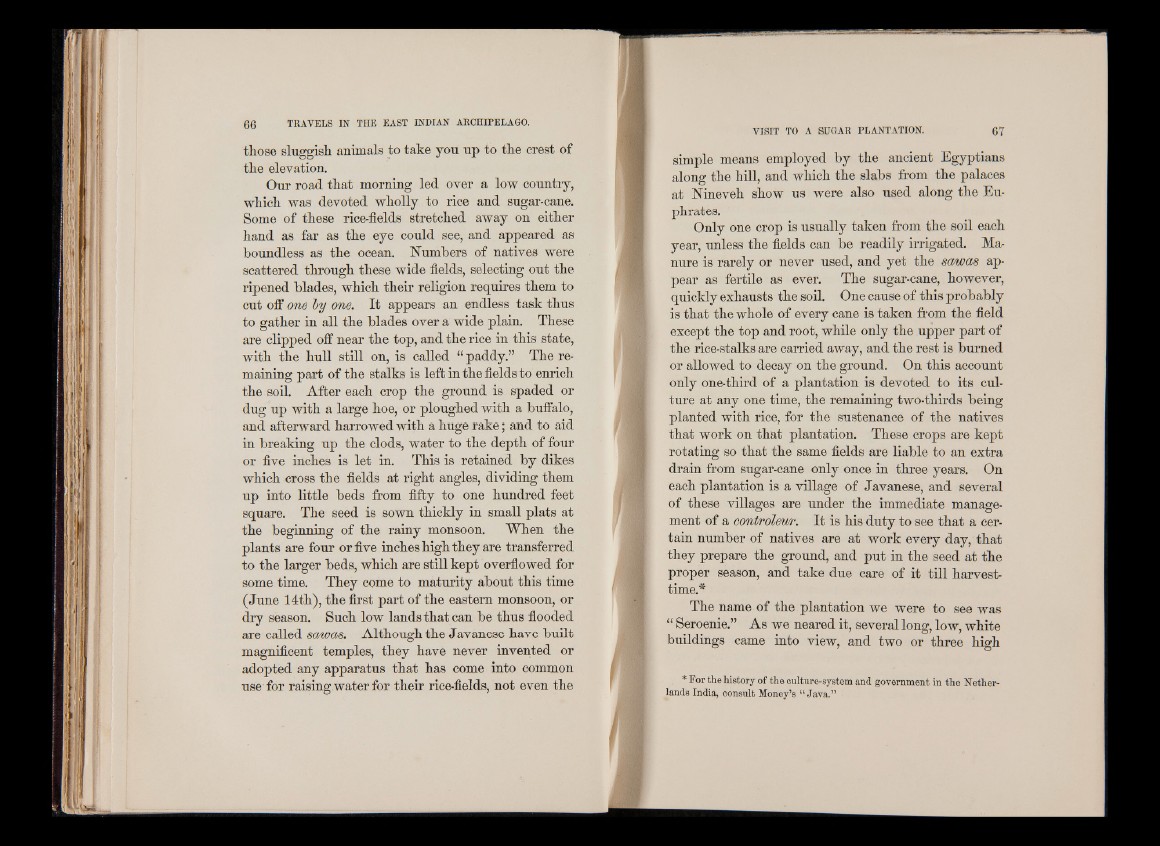
those sluggish animals to take you up to the crest of
the elevation.
Our road that morning led over a low country,
which was devoted wholly to rice and sugar-cane.
Some of these rice-fields stretched away on either
hand as far as the eye could see, and appeared as
boundless as the ocean. Numbers of natives were
scattered through these wide fields, selecting out the
ripened blades, which their religion requires them to
cut off one by one. It appears an endless task thus
to gather in all the blades over a wide plain. These
are clipped off near the top, and the rice in this state,
with the hull still on, is called “ paddy.” The remaining
part of the stalks is left in the fields to enrich
the soil. After each crop the ground is spaded or
dug up with a large hoe, or ploughed with a buffalo,
and afterward harrowed with a huge rake; and to aid
in breaking up the clods, water to the depth of four
or five inches is let in. This is retained by dikes
which cross the fields at right angles, dividing them
up into little beds from fifty to one hundred feet
square. The seed is sown thickly in small plats at
the beginning of the rainy monsoon. When the
plants are four or five inches high they are transferred
to the larger beds, which are still kept overflowed for
some time. They come to maturity about this time
(June 14th), the first part of the eastern monsoon, or
dry season. Such low lands that can be thus flooded
are called sawas. Although the Javanese have built
magnificent temples, they have never invented or
adopted any apparatus that has come into common
use for raising water for their rice-fields, not even the
VISIT TO A SUGAR PLANTATION. 67
simple means employed by the ancient Egyptians
along the hill, and which the slabs from the palaces
at Nineveh show us were also used along the Euphrates.
Only one crop is usually taken from the soil each
year, unless the fields can be readily irrigated. Manure
is rarely or never used, and yet the sawas appear
as fertile as ever. The sugar-cane, however,
quickly exhausts the soil. One cause of this probably
is that the whole of every cane is taken from the field
except the top and root, while only the upper part of
the rice-stalks are carried away, and the rest is burned
or allowed to decay on the ground. On this account
only one-third of a plantation is devoted to its culture
at any one time, the remaining two-thirds being
planted with rice, for the sustenance of the natives
that work on that plantation. These crops are kept
rotating so that the same fields are liable to an extra
drain from sugar-cane only once in three years. On
each plantation is a village of Javanese, and several
of these villages are under the immediate management
of a controleur-. It is his duty to see that a certain
number of natives are at work every day, that
they prepare the ground, and put in the seed at the
proper season, and take due care of it till harvesttime.*
The name of the plantation we were to see was
“ Seroenie.” As we neared it, several long, low, white
buildings came into view, and two or three high
* For the history of the culture-system and government in the Netherlands
India, consult Money’s “ Java.”